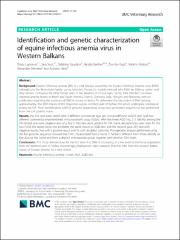Identification and genetic characterization of equine infectious anemia virus in Western Balkans

View/
Date
2021Author
Lupulović, Diana
Savić, Sara
Gaudaire, Delphine
Berthet, Nicolas
Grgić, Živoslav
Matović, Kazimir
Deshiere, Alexandre
Hans, Aymeric
Metadata
Show full item recordAbstract
Background: Equine infectious anemia (EIA) is a viral disease, caused by the Equine Infectious Anemia virus (EIAV)
belonging to the Retroviridae family, genus Lentivirus. Horses (or equids) infected with EIAV are lifelong carriers and
they remain contagious for other horses even in the absence of clinical signs. So far, EIAV infection has been
reported among horses in North and South America, France, Germany, Italy, Hungary and Romania, with no
publication regarding the presence of EIAV in horses in Serbia. To determine the circulation of EIAV among,
approximately, the 5000 horses of the Vojvodina region, northern part of Serbia, 316 serum undergone serological
testing for EIA. Then, identification and full genome sequencing using next generation sequencing was performed
from one EIA positive horse.
Results: the 316 sera were tested with 3 different commercial agar gel immunodiffusion (AGID) tests and two
different commercial enzyme-linked immunosorbent assay (ELISA). With the three AGID kits, 311 (98.4%) among the
316 tested sera were negative and only five (1.6%) sera were positive for EIA. Some discrepancies were seen for the
two ELISA kits tested since one exhibited the same results as AGID test and the second gave 295 sera with
negative results, five with a positive result and 16 with doubtful outcome. Phylogenetic analysis performed using
the full genome sequence showed that EIAV characterized from a horse in Serbia is different from those identify so
fare around the world and form a distinct and separate group together with another EIAV strain.
Conclusions: This study demonstrate for the first time that EIAV is circulating at a low level in the horse population
from the Northern part of Serbia. Interestingly, phylogenetic data indicates that this EIAV from the western Balkan
region of Europe belongs to a new cluster
